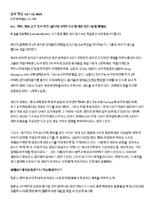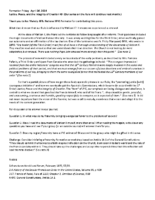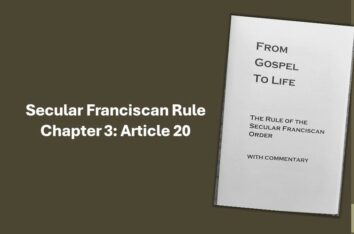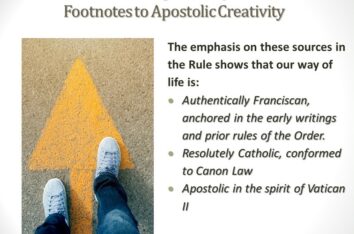(En español abajo) THE KOREAN TRANSLATION IS ALSO ATTACHED IN A SEPARATE PDF
Justice, Peace, and the Integrity of Creation #3 (Our series on the Rule will continue next month.)
Thank you to Joe Makely, OFS, National JPIC Animator for contributing this piece.
What does it mean that our Rule is influenced by Vatican II? It means we experienced a renewal.
At the close of Vatican II, the friars led the tertiaries to follow long sought after reforms. Their guidelines included the major documents of Vatican II about the laity. It was a very exciting time for the Third Order, when we finally gained our autonomy and an affirmation of the lay charism. One of the luminaries was Fr. Philip Marquard, OFM, who wrote in 1970: “Any leader [of the Third Order] must first of all have a thorough understanding of the documents of Vatican II. They must be read and reread so that one understands their true direction. The Church is not looking for mere adaptation, but renewal. There was nothing Pope John stressed more strongly than this point.” (See note 1)
The process of renewal included a very serious study of the early penitents, as described by Mrs. Pamona Pefanis, a Third Order participant from Canada who attended the gatherings in Assisi: “The strongest impression I received from the entire historians’ congress was that the 13th Century Penitenti were deeply involved in the social and political problems of their period, and that we must emerge from our cocoon of pious devotions and embroil ourselves in the problems of our day, bringing to them the same evangelical fervor that motivated the 13th Century members of our order.” (See note 2)
So that’s a partial picture of how we got those lively apostolic phrases in our Rule, like “promoting justice [with] courageous initiatives” and how we eventually got the Apostolic Commissions, which became (in accord with the 1st Order) Justice, Peace and the Integrity of Creation. The “how” of JPIC, our emphasis on loving dialogue and obedience, is central to what we do and that goes back to Francis himself, who said of his friars: “… they should be gentle, peaceful, and unassuming, courteous and humble, speaking respectfully to everyone, as is expected of them.” (See note 3) It did not mean departure from the vision of the founder, but was a call to restudy, reembrace that vision and adapt it to the needs of the current generation.
For discussion or to answer in your journal:
Question 1. In what ways is my fraternity bringing evangelical fervor to the problems of society?
Question 2. Have I read the documents of Vatican II myself, more than once? After reading them again, write down any questions you have and see if your group (or an outside source) will answer them for you.
Question 3. Does my region/fraternity have a JPIC animator? Discuss with the group who might be gifted in this area.
Challenge: Consider initiating a fraternity formation or workshop based on Article 14.1 of the General Constitutions: “They should commit themselves to a faith-inspired reflection on the Church, its mission in today’s world and the role of the Franciscan laity within it. They should take up the challenges and accept the responsibilities that this reflection will lead them to discover.” (See note 4)
Notes
1-Franciscan Herald and Forum, February 1970, 53,54.
2-A History of the Secular Franciscan Order in the United States, Volume IIA, p 409
3-ST. Francis of Assisi, Rule of 1223, Chapter 3, Omnibus of Sources, P.60
4-OFS General Constitutions, Article 14.1
Formación (Por favor, comparta con su fraternidad local)
La justicia, la paz y la integridad de la creación #3 (Nuestra serie sobre la Regla continuará el mes próximo.)
Le agradecemos a Joe Makely, OFS, Animador nacional de JPIC por contribuir esta materia.
¿Qué significa que nuestra Regla está influenciada por el Vaticano II? Significa que experimentamos una renovación.
Al final del Concilio Vaticano II, los frailes condujeron a los terciarios a seguir las reformas largamente buscadas. Sus directrices incluían los principales documentos del Vaticano II sobre los laicos. Fue un tiempo muy emocionante para la Tercera Orden, cuando finalmente obtuvimos nuestra autonomía y una afirmación del carisma laical. Una de las luminarias fue el P. Philip Marquard, OFM, quien escribió en 1970: “Cualquier líder [de la Tercera Orden] debe, en primer lugar, tener un conocimiento profundo de los documentos del Vaticano II. Hay que leerlos y releerlos para que uno entienda su verdadera dirección. La Iglesia no busca una mera adaptación, sino una renovación. No había nada que el Papa Juan enfatizara con más fuerza que este punto. (Vea la nota 1)
El proceso de renovación incluyó un estudio muy serio de los primeros penitentes, como lo describe la Sra. Pamona Pefanis, una participante de la Tercera Orden de Canadá que asistió a las reuniones en Asís: “La impresión más fuerte que recibí de todo el congreso de historiadores fue que los penitenti del siglo XIII estaban profundamente involucrados en los problemas sociales y políticos de su época, y que debíamos salir de nuestro capullo de devociones piadosas y enredarnos en los problemas de nuestro tiempo, llevándoles el mismo fervor evangélico que motivó a los 13ésimo Centenarias miembros de nuestra orden”. (Vea la nota 2)
Así que esa es una imagen parcial de cómo obtuvimos esas frases apostólicas vivas en nuestra Regla, como “promover la justicia [con] iniciativas valientes” y cómo finalmente obtuvimos las Comisiones Apostólicas, que se convirtieron (de acuerdo con la 1ª Orden) la justicia, la paz y la integridad de la creación. El “cómo” de JPIC, nuestro énfasis en Diálogo amoroso y obediencia, es central en lo que hacemos y que se remonta al mismo Francisco, que dijo de sus frailes: “… Deben ser gentiles, pacíficos y modestos, corteses y humildes, hablando con respeto a todos, como se espera de ellos. (Vea la nota 3) El Concilio Vaticano II no significó apartarse de la visión del fundador, sino que fue un llamado a reestudiar, retomar esa visión y adaptarla a las necesidades de la generación actual.
Para platicar o contestar en su diario:
Pregunta 1. ¿Cómo está mi fraternidad llevando fervor evangélico a los problemas de la sociedad?
Pregunta 2. ¿He leído yo mismo los documentos del Vaticano II, más de una vez? Después de leerlos otra vez, apunte las preguntas que tenga y vea si alguien en su grupo (o un “experto” de afuera) tenga las respuestas.
Pregunta 3. ¿Mi región/fraternidad tiene un animador de JPIC? (Hablen con su grupo para ver si pueden pensar en quién tiene talento en esta área.)
Desafío: Considerar la posibilidad de iniciar una formación o taller de fraternidad basado en el artículo 14, p1 de las Constituciones Generales: “Deben comprometerse a una reflexión inspirada en la fe sobre la Iglesia, su misión en el mundo de hoy y el papel de los laicos franciscanos dentro de ella. Deben asumir los desafíos y aceptar las responsabilidades que esta reflexión les llevará a descubrir”. (Vea la nota 4)
Notas
1-Heraldo y Foro Franciscano, febrero de 1970, 53,54.
2-Una historia de la Orden Franciscana Seglar en los Estados Unidos, Volumen IIA, p 409
3-San Francisco de Asís, Regla de 1223, Capítulo 3, Ómnibus de Fuentes, p.60
4-Constituciones Generales de la OFS, artículo 14, p 1
Diane F. Menditto, OFSVice Minister, National Fraternity, Secular Franciscan Order USAListen – Discern – Go Forth National Theme 2022-2025




